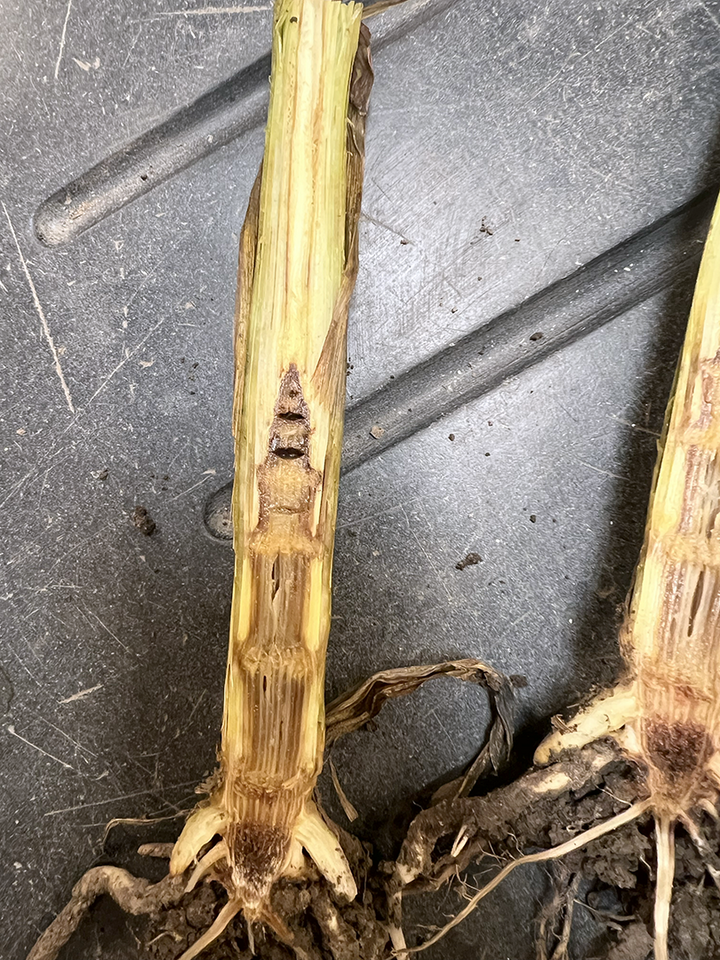Several diseases have been confirmed in samples from corn fields across the state that were damaged by earlier storms. Severe weather conditions including hail, high wind, heavy rain and sandblasting have caused plant injury, which has provided an opportunity for pathogens to infect. Producers and consultants should monitor for diseases and assess the risks for later in the season.
Bacterial Diseases
Bacterial diseases in corn have been confirmed in fields damaged by severe weather. Goss’s bacterial wilt and blight, and bacterial leaf streak have been confirmed. Current warm temperatures, rainfall/overhead irrigation and wind will support spread and further development of these diseases.
Goss's Bacterial Wilt and Blight
Goss’s bacterial wilt and blight (caused by Clavibacter nebraskensis) can cause different disease symptoms depending upon the crop stage when plants are infected. The most common symptoms are leaf “blight” lesions. These lesions have water-soaked, discolored lesions, especially along wounds. Lesions may have dark green/black “freckles” or flecks on the edges of dark, water-soaked lesions (Figure 1) that are unique to Goss’s blight. Freckles may appear translucent when backlit by bright light such as the sun.
The second feature of the disease is the presence of bacterial exudate, often called “bacterial ooze” on the leaves, which occurs when the bacteria are secreted on the surface of the lesions. Once the ooze is dried, it will give the leaf a shiny or sparkling appearance. Be sure to check the bottom side of the leaf carefully as well, as the ooze may be washed away by rainfall or overhead irrigation.
When plants are damaged early, usually by V6 stage, they can sometimes become infected at multiple nodes and develop a less common systemic wilt. Affected plants may be stunted and wilted and seemingly “melt down” quickly. These plants often die during early season as they are overcome with bacteria throughout. Discoloration is visible inside the stalk but does not have the same putrid odor associated with bacterial stalk rot (below).




Bacterial Leaf Streak
Bacterial leaf streak is caused by Xanthomomas vasicola pv. vasculorum. Symptoms are interveinal leaf streaks that are brown, tan or yellow, which can be short or very long (Figure 2a). Lesions are often strikingly yellow when backlit against the sun. A key characteristic of lesions is the wavy, jagged margins, which can be used to differentiate them from the smooth, rectangular lesions of the fungal disease, gray leaf spot. These bacteria do not require wounds to infect plants, but bacterial leaf streak can be more common after heavy, wind-driven rain.


Bacterial Stalk Rot
Bacterial stalk rot, caused by Erwinia dissolvens or E. chrysanthemi, survives in corn and sorghum residue. Symptoms start as lesion development on the lower stalk or discoloration of a leaf sheath and then systematically move up the stalk and throughout the plant. A foul “fishy” odor is common, and the top of the plant can often be easily removed (Figure 3). As the disease progresses, the stalk may rot and the plant can collapse. Bacterial stalk rot can affect the plant at any node and when infection occurs high on the plant it may impair normal tasseling. When stalks are split, there is internal discoloration and soft slimy rot especially at the nodes but can spread throughout the plant and may hollow out stalks.

Fungal Diseases
Common Smut
Common smut (Figure 4) occurs in almost every field in Nebraska but is more prevalent after plants are injured. This disease is caused by the fungus Ustilago maydis and can also be called “boil or blister smut.” Smut galls may look like mushrooms or warts and can develop on any plant part, including leaves (Figure 4), stalks and tassels, but it’s most recognizable when they develop on the ear. Initially, galls are white to gray in color and fleshy to the touch. As the gall matures, it ruptures, releasing a large amount of black teliospores that overwinter in the soil for future years.


Diagnostics
Some of these diseases may mimic symptoms of other diseases that may require very different management strategies. All of those listed are caused by pathogens that overwinter, so disease may return in subsequent years when conditions are favorable. Be sure to submit samples to the UNL Plant and Pest Diagnostic Clinic for help identifying diseases and other problems. Some commercially available tests are available that can successfully identify some of these pathogens. However, their hyper-sensitivity can lead to false positive results when samples that are easily contaminated by handling, so take care when interpreting results.
Management
Unfortunately, fungicides are ineffective against the diseases listed here, making accurate diagnoses important for effective management decisions. Some bactericides are labeled for corn, but their use has had inconsistent results on these diseases and can be cost-prohibitive since most are not absorbed by the plant and require repeated applications. Selecting more resistant corn hybrids (with better disease ratings) for these diseases can help reduce disease pressure and losses.

